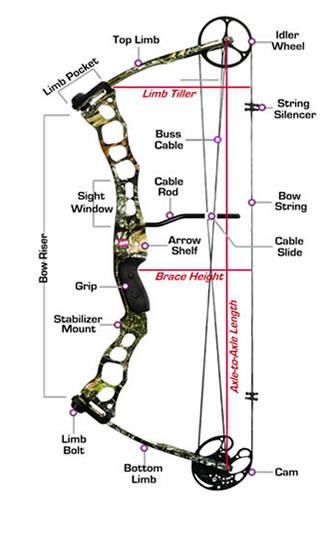
Compound Bows
There are several factors to consider when purchasing a compound bow. One important factor is whether or not you have the ability to handle this type of bow. Different from the traditional long bow, there are several components that form the makeup of the compound bow.
Cams
When looking at a compound bow you will notice two wheels at either end of the draw string. These are the cams - which are used to help balance the force generated by the drawstring being pulled back as well as controlling the speed at which you can draw. Cams can make the bow easier to pull or much harder.
Target Shooting - A "soft cam" is used to enable an easy and steady draw allowing you to concentrate on your accuracy. This enables multiple shots without worrying about your arm tiring. With this setup you sacrifice power and energy.
Hunting - Hunters need powerful, piercing shots that are generated from speed and force. An aggressive cam will provide you with excellent power.
The above mentioned cam types are known as two-wheel types. There is one more type of cam called the single cam, which uses one wheel instead of two - as the name implies. There are a few advantages over this bow type:
A single cam system is more likely to maintain its integrity over time. Things like heat and continuous stretching will affect the cams naturally. These same factors can cause uneven wear on dual cam systems, which will in turn cause an unbalanced draw cause poor arrow flight.
With a simgle cam, there is no problem remaining in tune with another cam, so you can expect more accuracy over a longer period of time. It is however more difficult to start when tuning.
Single cams are quieter, which is a huge benefit for hunters.
A drawback for the single cam is that the notch for nocking the arrow does not maintain a consistent travel level through the shot possibly causing your arrow to move vertically.
Hybrid cams are relatively new, but they do offer several benefits. They are quiet, fast and smooth. They also eliminate vibration and timing issues associated with the dual cam systems.
Limb Style
Limbs are two flexible arms which extend from the center portion of the bow up to the cams which are located at the ends of these limbs. With compound bows, the limbs are designed to be very stiff, making them generate more power than a traditional bow. Typically they are constructed of lightweight carbon fiber composite and they can be designed two ways: standard or split. A split limb consists of two pieces and the standard limb is a single piece. For lighter and quieter bows, split limbs are the preferred choice.
Bow Dimensions
The speed and strength of an arrow trajectory depends on several factors, most of them dealing with dimensions: Your arm length, bow length, weight and abilities. Typically when referring to compound bows you will hear the following terms:
Bow Length - A bow's length is measured in inches from top to bottom cam. Choosing the proper length is critical for optimum maneuverability and stability.
Draw Weight - The amount of strength it takes you to draw the string back. This is measured in pounds. The users weight and strength play a big role as well as the cam type which is on the bow.
Draw Length - Measured from hand to hand in a flexed, drawn back and ready to shoot position. The length of the draw determines how fast the arrow will be shot. Like a rubber band, the more you pull it, the farther and faster it flies. It must be matched with the proper draw weight to get optimum results.
The bow can be short and light (32 inches) or long and heavy (48 inches). The longer the bow, the more accurate it will be, which is ideal for target shooters. Hunters however, will find that shorter bows will allow for greater mobility maneuvering through branches and the like but will sacrifice stability and accuracy. Most users will have to compromise about which factors are most important for their specific needs. Beginners should start between 38 and 44 inches.
Draw length is really a matter of how long your arm is, you will have to measure this yourself. You want to be able to draw the string comfortably at a full extension (back to the corner of your mouth) for at least 15 seconds. As for the draw weight, 50 to 70 pounds is adequate for an adult. Juniors have special bows built to compensate the draw weight to suit their muscle capacity. The trick to finding the right weight has to do with how comfortable you feel when drawing the string.
Risers
Risers are part of the bow that you grip and come in two varieties: flex or reflex. A reflex riser is slower but more giving when you shoot. Typically they are constructed of aluminum or magnesium. Machine aluminum can be anodized which helps the paint last longer than that on a cast handle. Magnesium is heavier than the machined aluminum risers and typically are quieter.
Top Manufacturers
• Bear Archery
• Bowtech
• Browning
• Parker
• PSE
|
